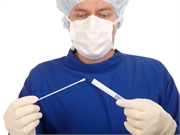No significant difference found in detection of CIN2+ or treatment with intervention versus usual care
WEDNESDAY, Nov. 6, 2019 (HealthDay News) — Mailing human papillomavirus (HPV) kits to underscreened women is associated with increased screening uptake but does not significantly increase precancer detection or treatment, according to a study published online Nov. 6 in JAMA Network Open.
Rachel L. Winer, Ph.D., M.P.H., from the University of Washington in Seattle, and colleagues conducted a randomized clinical trial involving women aged 30 to 64 years with a primary care physician and no Papanicolaou test within three years and five months. The control group received usual care (annual patient reminders and ad hoc outreach; 9,891 women), while the intervention group also received a mailed HPV self-sampling kit (9,960 women).
The researchers found that in the intervention and control groups, 12 and eight women with cervical intraepithelial neoplasia grade 2 or worse were detected, respectively (relative risk, 1.49; 95 percent confidence interval, 0.61 to 3.64) and 12 versus seven cases were treated (relative risk, 1.70; 95 percent confidence interval, 0.67 to 4.32). However, the intervention group did have higher screening uptake (26.3 versus 17.4 percent; relative risk, 1.51; 95 percent confidence interval, 1.43 to 1.60).
“Health care systems in the United States considering implementing primary HPV screening and outreach strategies with HPV self-sampling should focus on approaches to increase kit uptake and follow-up of positive results,” the authors write. “Additional research efforts should consider a variety of strategies to increase cervical cancer screening.”
Copyright © 2019 HealthDay. All rights reserved.








